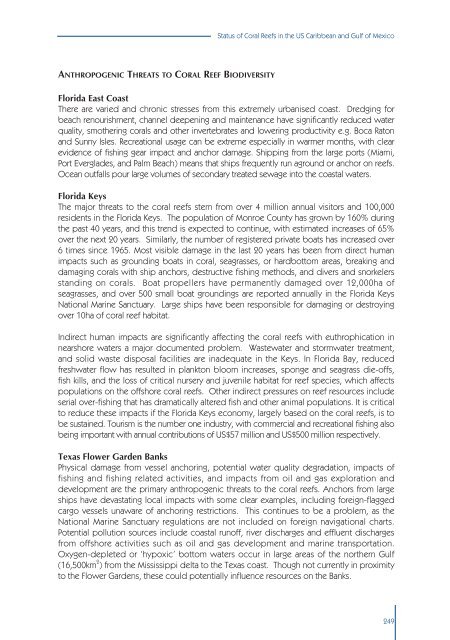Status of Coral Reefs of the World 2000
Status of Coral Reefs of the World 2000.pdf
Status of Coral Reefs of the World 2000.pdf
- No tags were found...
You also want an ePaper? Increase the reach of your titles
YUMPU automatically turns print PDFs into web optimized ePapers that Google loves.
<strong>Status</strong> <strong>of</strong> <strong>Coral</strong> <strong>Reefs</strong> in <strong>the</strong> US Caribbean and Gulf <strong>of</strong> Mexico<br />
ANTHROPOGENIC THREATS TO CORAL REEF BIODIVERSITY<br />
Florida East Coast<br />
There are varied and chronic stresses from this extremely urbanised coast. Dredging for<br />
beach renourishment, channel deepening and maintenance have significantly reduced water<br />
quality, smo<strong>the</strong>ring corals and o<strong>the</strong>r invertebrates and lowering productivity e.g. Boca Raton<br />
and Sunny Isles. Recreational usage can be extreme especially in warmer months, with clear<br />
evidence <strong>of</strong> fishing gear impact and anchor damage. Shipping from <strong>the</strong> large ports (Miami,<br />
Port Everglades, and Palm Beach) means that ships frequently run aground or anchor on reefs.<br />
Ocean outfalls pour large volumes <strong>of</strong> secondary treated sewage into <strong>the</strong> coastal waters.<br />
Florida Keys<br />
The major threats to <strong>the</strong> coral reefs stem from over 4 million annual visitors and 100,000<br />
residents in <strong>the</strong> Florida Keys. The population <strong>of</strong> Monroe County has grown by 160% during<br />
<strong>the</strong> past 40 years, and this trend is expected to continue, with estimated increases <strong>of</strong> 65%<br />
over <strong>the</strong> next 20 years. Similarly, <strong>the</strong> number <strong>of</strong> registered private boats has increased over<br />
6 times since 1965. Most visible damage in <strong>the</strong> last 20 years has been from direct human<br />
impacts such as grounding boats in coral, seagrasses, or hardbottom areas, breaking and<br />
damaging corals with ship anchors, destructive fishing methods, and divers and snorkelers<br />
standing on corals. Boat propellers have permanently damaged over 12,000ha <strong>of</strong><br />
seagrasses, and over 500 small boat groundings are reported annually in <strong>the</strong> Florida Keys<br />
National Marine Sanctuary. Large ships have been responsible for damaging or destroying<br />
over 10ha <strong>of</strong> coral reef habitat.<br />
Indirect human impacts are significantly affecting <strong>the</strong> coral reefs with euthrophication in<br />
nearshore waters a major documented problem. Wastewater and stormwater treatment,<br />
and solid waste disposal facilities are inadequate in <strong>the</strong> Keys. In Florida Bay, reduced<br />
freshwater flow has resulted in plankton bloom increases, sponge and seagrass die-<strong>of</strong>fs,<br />
fish kills, and <strong>the</strong> loss <strong>of</strong> critical nursery and juvenile habitat for reef species, which affects<br />
populations on <strong>the</strong> <strong>of</strong>fshore coral reefs. O<strong>the</strong>r indirect pressures on reef resources include<br />
serial over-fishing that has dramatically altered fish and o<strong>the</strong>r animal populations. It is critical<br />
to reduce <strong>the</strong>se impacts if <strong>the</strong> Florida Keys economy, largely based on <strong>the</strong> coral reefs, is to<br />
be sustained. Tourism is <strong>the</strong> number one industry, with commercial and recreational fishing also<br />
being important with annual contributions <strong>of</strong> US$57 million and US$500 million respectively.<br />
Texas Flower Garden Banks<br />
Physical damage from vessel anchoring, potential water quality degradation, impacts <strong>of</strong><br />
fishing and fishing related activities, and impacts from oil and gas exploration and<br />
development are <strong>the</strong> primary anthropogenic threats to <strong>the</strong> coral reefs. Anchors from large<br />
ships have devastating local impacts with some clear examples, including foreign-flagged<br />
cargo vessels unaware <strong>of</strong> anchoring restrictions. This continues to be a problem, as <strong>the</strong><br />
National Marine Sanctuary regulations are not included on foreign navigational charts.<br />
Potential pollution sources include coastal run<strong>of</strong>f, river discharges and effluent discharges<br />
from <strong>of</strong>fshore activities such as oil and gas development and marine transportation.<br />
Oxygen-depleted or ‘hypoxic’ bottom waters occur in large areas <strong>of</strong> <strong>the</strong> nor<strong>the</strong>rn Gulf<br />
(16,500km 2 ) from <strong>the</strong> Mississippi delta to <strong>the</strong> Texas coast. Though not currently in proximity<br />
to <strong>the</strong> Flower Gardens, <strong>the</strong>se could potentially influence resources on <strong>the</strong> Banks.<br />
249
















